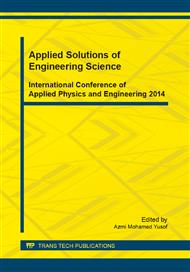p.73
p.81
p.95
p.100
p.106
p.111
p.118
p.123
p.128
Evaluation of Medium-Rise Reinforced Concrete Building Performance under Low Intensity Earthquake Effect
Abstract:
The paper presents an evaluation of medium-rise reinforced concrete building in Johor which is subjected to low intensity earthquake effects. Even-though Malaysia is outside the earthquake region, the country had experienced and did suffer from major cases due earthquake in the past like tsunami. Engineers should concern and consider the loading for reinforced concrete building due to earthquake in the building design procedure. The study addresses the performance of critical frame reinforced concrete building when subjected to earthquake motion. The building of Marlborough College Malaysia chooses as model. The building was analyzed using Finite Element Modelling (FEM) using IDARC (2D) with respect to various earthquake intensities obtained from Time History Analysis (THA) data. The yield point at the beam-column connections was analyzed to determine the damage index and damage level of the building subjected to the various earthquake intensities. The building performed the early yielding point at 4.2650 sec for beam element at the intensity of 0.15g. Based on the results, it was found that the critical frame of Condominium Marlborough College Malaysia can stand an earthquake occurrence with intensity up to 0.20g. There is no structural damage some non-structural damage is expected in the non-linear analysis of modal frames. The building was also categorized as the one in the light damage level.
Info:
Periodical:
Pages:
106-110
Citation:
Online since:
October 2014
Authors:
Price:
Сopyright:
© 2014 Trans Tech Publications Ltd. All Rights Reserved
Share:
Citation:


